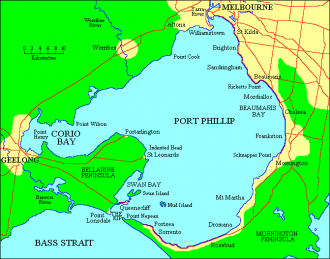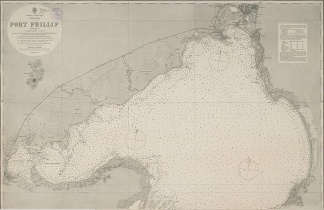Port Phillip
From CruisersWiki
 Port Phillip Bay | |
| | |
| | 38°09.56′S, 144°52.89′E |
|---|---|
| | Photo gallery |
| | Local chartlet |
Port Phillip, often known as Port Philip Bay, incorporates Corio Bay to the west and joins Bass Strait with Victoria's capital city Melbourne and Victoria's largest regional city Geelong. The bay is large, covering approximately 1,930 km2 (745 mi2) with a shoreline of approximately 264 km (164 mi) with a single opening to the sea in the south known as "The Heads".
Although the bay is relatively shallow, it is mostly navigable but care is required in the southern area which has two navigable channels: the West Channel usually used by recreational vessels and has a depth of around 4m; and the South Channel that is used by all commercial traffic and has a depth of around 12m. The bay has Yacht Clubs and Marinas dotted around the shoreline.
The Yarra River flows into the northern end of the bay and is the site of both the city of Melbourne and the Port of Melbourne, which is Australia's busiest commercial port. To service this port, Port Phillip Heads and the mouth of the Yarra River were dredged to allow deeper drafted vessels to enter the bay. This work was started in 2004 and finished in late 2009 and has been the source of great controversy by environmental groups.
Communication
- See Melbourne]
Charts
- Australian Hydrographic Service
- AUS 158 Entrance to Port Phillip
- AUS 143 Port Phillip - The Rip
- AUS 154 Port Melbourne
Weather
The prevailing wind for the West and Central Victorian Coast is South West all year round, but during summer Northerlies and North Westerlies are common, and during Autumn (Fall) Easterlies can prevail for periods. Weather patterns always flow west to east, with low and high pressure systems developing in the Southern and Indian Oceans and travelling across the Great Australian Bight, across Victoria and on through the Tasman Sea, drifting south east to New Zealand.
Passages
Popular passages/routes, timing, etc.
Islands
See Melbourne]
The approaches to Port Phillip Bay at "The Heads" whether from the East, South or West, are free from hazards. However, the heads themselves must be approached with extreme care. Due to the larges body of water and the relatively small opening, the area in the middle of the heads, known as The Rip, has tidal streams that can run in excess of 6 knots and large breaking seas can be encountered in wind against tide situations.
The recommended timing of entry through the heads is at 'slack water', which occurs 3 hours after high or low water at Port Philip Heads and the ideal is 3 hours after low water as this allows the trip up the bay on a rising tide with a favourable tidal stream. This information can be found from the Victorian Tide Tables or from the Bureau of Meteorology web site.
When approaching the heads, Point Lonsdale Lighthouse can be seen on the western side, which has a characteristic of a group flash 2 every 15 seconds. At night, the light also displays a single red light to show the first half of an ebbing tide, two red lights to show the second half of an ebbing tide, a single green light to indicate the first half of a flooding tide and two green lights to indicate the second half of a flooding tide. If in any doubt at all call "Lonsdale VTS" (Vessel Traffic Service) on VHF channel 12 or 16 and they will tell you the state of the tide and also conditions at the heads. As a courtesy, it is a good idea to call Lonsdale VTS anyway and ask if there is any commercial traffic. Vessels over 35 metres require a pilot.
There are 4 recognised channels into the heads, east, central, west and four fingers west. These channels are detailed on the Australian chart AUS 158 "Entrance to Port Phillip" and are aligned with 4 lighthouses on Shortland Bluff inside the heads, a high light and 3 low lights, east central and west. The recommended channels for recreational vessels are the west channel or four fingers west, these channels keep you away from commercial traffic that uses the central channel.
Hazards at the heads include Lonsdale reef on the western side and corsair rock on the eastern side. Neither of these hazards come into play if you are aligned with any of the recognised channels.
Entrance
- Contact Customs and Quarantine for information on anchorage/berthing
- See also Australia#EntranceAustralia
Berthing
- Port Melbourne
- Port Henry (Geelong)
Marinas & Yacht Clubs
Anchorages
Yacht Repairs and Services
Marine Stores
Submit addresses and contact details of marine related businesses that are of interest to cruisers.
Repairs/Yards
Fuel, Water, & Electricity
- Fuel
- Give details on fuel
- Water
- Give details on water
- Electricity
- Give details on electricity
Things to do Ashore
Tourism
List places of interest, tours, etc.
Grocery & Supply Stores
Eateries
Internet/WiFi
Available?
Laundry
Motorbike & Car Rentals
Garbage Disposal
?
Transportation
List transportation (local and/or international.)
Friends
Contact details of "Cruiser's Friends" that can be contacted for local information or assistance.
Forums
List links to discussion threads on partnering forums. (see link for requirements)
Links
- Port Phillip at the Wikipedia
References & Publications
See Australia.
Comments
We welcome users' contributions to the Wiki. Please click on Comments to view other users' comments, add your own personal experiences or recommend any changes to this page following your visit.
Verified by
Date of member's last visit to Port Phillip and this page's details validated:
| This is a usable page of the cruising guide. However, please contribute if you can to help it grow further. Click on Comments to add your personal notes on this page or to discuss its contents. Alternatively, if you feel confident to edit the page, click on the edit tab at the top and enter your changes directly. |
| |
|---|
|
Names: Buena Vista, Haiqu |
